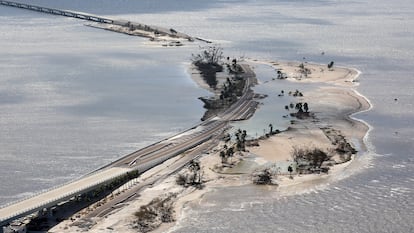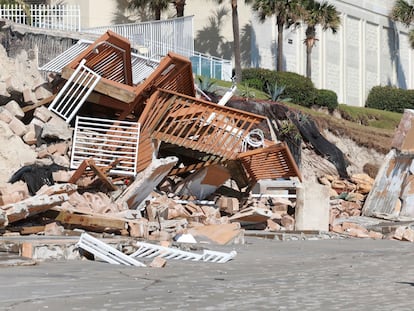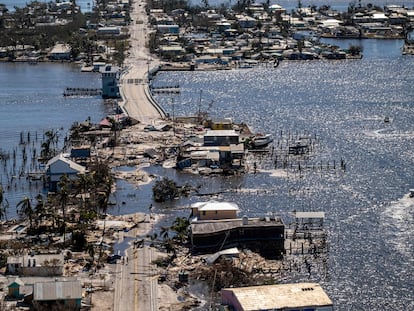Hurricane Ian: The high price of living in paradise
The devastation left by the most recent big storm to sweep through Florida has renewed the debate about living in areas of great natural beauty that are highly vulnerable to climate change

For retired Americans, sun worshipers and beach lovers, the barrier islands off the southwest coast of Florida are the closest thing to (an affordable) paradise on Earth – until Hurricane Ian slammed the area on September 28. Today, places like Fort Myers Beach, Pine Island, Sanibel and Captiva are synonymous with destruction. Large swaths of these communities were ravaged when Ian made landfall as a category four hurricane (just shy of the maximum category five) with winds of over 158 mph (250 kph), flattening entire neighborhoods and killing at least 127 people. Thousands are now homeless and waging battle with their insurance companies – if they even had homeowner’s insurance policies. The question everyone is asking – is it worth paying such a high price to live in paradise?
People who move to these areas know that they are very exposed to the vagaries of nature, both good and bad. But experts agree that the southeastern coasts of the United States are becoming ground zero for climate change, because hurricanes like Ian gather strength are they travel over the increasingly warm waters of the Gulf of Mexico.

Now, as the slow process of rebuilding gets underway, a debate rages over what can be done to minimize the damage from the next storm. “I’m afraid we’re going to make the same mistakes again and rebuild houses the same way as before the hurricane,” Robert S. Young told EL PAÍS. Young teaches at Western Carolina University, where he directs a program to study developed coastlines. Ian caused five deaths in North Carolina even though it had degraded to tropical storm strength. “If you don’t have a good plan in place, it’s hard to keep a level head when government disaster relief money is flowing in and people are anxious to get back into their homes,” said Young. According to a spokesman for the Federal Emergency Management Agency (FEMA), “over $210 million in aid has been approved for the more than 128,000 people and homes affected by Hurricane Ian.”
Storms come and go, but Young says the United States is still “not having a productive conversation about long-term protection for areas that will be affected by sea level rise and hurricanes with increasingly strong winds and high rainfalls.” It’s not a problem unique to Florida, and affects dozens of communities along the eastern seaboard of the United States, “from Maine to Texas,” said Young. And elsewhere. “We have seen wave after wave of people who live too close to the sea. Spain is no exception,” he said.
Yoca Arditi-Rocha is the executive director of The CLEO Institute, a non-profit organization dedicated to climate crisis education and advocacy in Florida. “Rebuilding would mean playing hurricane Russian roulette,” she said. Shortly before Ian hit, The CLEO Institute launched a prescient public awareness campaign – “Don’t Let the Sunshine State Become the Emergency State!” Arditi-Rocha told EL PAÍS in an email, “We didn’t know [when they launched the campaign] what Mother Nature was up to.” Her organization advocates “stricter building codes, minimum structure elevations to withstand sea level rise, underground power lines, and access to solar power with battery storage.”
Arditi-Rocha said: “The good news is that solutions exist.” And the bad news? “As a society, we’re not demanding them.” She cites Babcock Ranch, an innovative community north of Fort Myers that garnered media attention in the aftermath of Hurricane Ian. The homes in this community are built to withstand hurricanes. All power lines are underground to protect them from strong winds, and stormwater retention ponds keep homes from flooding. Solar energy provides a steady supply of electricity and internet access. After Ian, large swaths of Florida lost power (2.6 million people), internet service, cell phone service, drinking water and gasoline.
Robert Young notes that after Hurricane Sandy devastated parts of New Jersey in 2012, the state bought back some of the hurricane victims’ land to prevent them from rebuilding in unsuitable locations. Florida Governor Ron DeSantis has not announced any such measures.
DeSantis, who seems to be positioning himself as a Republican candidate for the presidency in 2024, has made numerous trips to areas affected by the hurricane, although he has avoided talking about climate change. “Years of Republican leadership in Florida have relegated the state to the dark ages because of partisan divisions,” said Arditi-Rocha. “Almost 75% of the Sunshine State’s electricity is generated using imported, polluting fossil fuels. The rest of it comes from nuclear power plants, and less than 1% from solar and wind generation. Our previous governor forbade state officials from saying ‘climate change.’ This governor has done a few things to address chronic flooding problems, but never acknowledged the root cause. It’s like trying to mop up a flooded bathroom while the faucet is still running.”
Many of the people hit hard by Hurricane Ian also seem oblivious to talk about root causes. People like Fort Myers resident Anne Dalton, who not only isn’t planning on moving out of the area, but also decided to ride out the hurricane at home. Many of those who didn’t evacuate in the days before the storm did so out of stubbornness, although local authorities in battered Lee County were criticized for delaying a mandatory evacuation order. But others, like the couple in their seventies standing in front of their flooded house on San Carlos Island (Fort Myers Beach), said they were ready to pack up and go “to another state, where there are no wildfires, like in California, or tornadoes, like in Kansas.”
The insurance companies take over
Some of the decisions facing hurricane victims, especially those with lower incomes, may be determined by their insurance settlements. It’s estimated that Hurricane Ian will cost insurance companies $60 billion in Florida alone, making it the second-costliest hurricane in US history after Katrina in 2005. And that’s not counting flood damage, which is another story altogether. “In this country, flood insurance is an add-on to a homeowner’s insurance policy, and it’s only mandatory in government-designated flood areas,” said Young, who doubts the accuracy of the federal government’s flood zone maps.
Florida’s low-lying inland areas suffered extensive flooding in the aftermath of Ian, including North Port, just up the coast from Fort Myers, where residents had to use canoes to get to homes flooded by chest-high water. Wendy Bowman told EL PAÍS that she and her husband didn’t have flood insurance, and she didn’t know if they could afford to pay for all the repairs themselves. What happened to the Bowmans’ North Port home has a name – compound flooding – which is what happens when overflowing rivers and streams can’t drain all the stormwater into the sea. And due to the climate crisis, Hurricane Ian dropped 10% more rain than previous storms of equal intensity.
Even though Florida’s coasts suffered the most damage, the state’s inland areas were also devastated. Many low-income Floridians like Hope Smith live miles from the beach in prefabricated houses that insurance companies won’t cover. Some insurance companies are expected to pull out of Florida altogether, like others did after past hurricanes. “Many of the houses on the idyllic barrier islands are second homes,” said Young. “And others are vacation rentals. Why would those homeowners want to rebuild and run the same risk again? Because they don’t live there – those houses are businesses.”
Florida’s stark inequality also dictates how people are responding in the aftermath of Ian. “If you’re rich, you don’t care about flood insurance. The most those policies cover is $250,000, which for a homeowner on Sanibel is what they paid for the car parked in the driveway. People who can’t afford to repair their homes will move out, and others with more money will take their places,” said Young, alluding to the hurricane’s unexpected aftereffect of gentrification.
Tu suscripción se está usando en otro dispositivo
¿Quieres añadir otro usuario a tu suscripción?
Si continúas leyendo en este dispositivo, no se podrá leer en el otro.
FlechaTu suscripción se está usando en otro dispositivo y solo puedes acceder a EL PAÍS desde un dispositivo a la vez.
Si quieres compartir tu cuenta, cambia tu suscripción a la modalidad Premium, así podrás añadir otro usuario. Cada uno accederá con su propia cuenta de email, lo que os permitirá personalizar vuestra experiencia en EL PAÍS.
¿Tienes una suscripción de empresa? Accede aquí para contratar más cuentas.
En el caso de no saber quién está usando tu cuenta, te recomendamos cambiar tu contraseña aquí.
Si decides continuar compartiendo tu cuenta, este mensaje se mostrará en tu dispositivo y en el de la otra persona que está usando tu cuenta de forma indefinida, afectando a tu experiencia de lectura. Puedes consultar aquí los términos y condiciones de la suscripción digital.
More information
Archived In
Últimas noticias
Most viewed
- Sinaloa Cartel war is taking its toll on Los Chapitos
- Oona Chaplin: ‘I told James Cameron that I was living in a treehouse and starting a permaculture project with a friend’
- Reinhard Genzel, Nobel laureate in physics: ‘One-minute videos will never give you the truth’
- Why the price of coffee has skyrocketed: from Brazilian plantations to specialty coffee houses
- Silver prices are going crazy: This is what’s fueling the rally











































